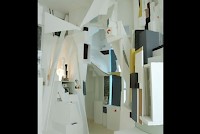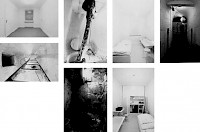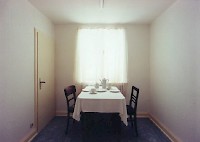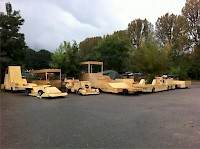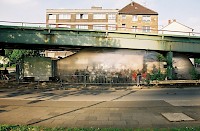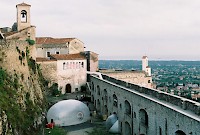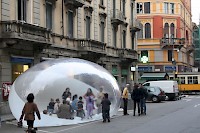This paper is meant to map some examples of a progressive doubt in the housing qualities of architecture. Some examples from modernity, will show that a deep rooted doubt in the protective and housing qualities of dwelling started to emerge in an artistic approach to architecture. At the crossing point of interior design, spatial painting practice and sculpture, a new modern architecture is imagined that seems an infinite territory of loss and threat. In the first decades of the 20th century this new architectural vision actually demonstrates a doubt in stability, order and sanity, it is politically oriented and emerged from both constructivist and dadaist premises. It was nevertheless also connected to the progressive delving into the domain of the subconscious.
Postmodern architecture, on the other hand, will be brought into connection with the deconstruction of architecture prophetised by Jacques Derrida, which will be cited in his interviews and Aphorisms on a performative architecture. This mobile, transformatory architecture, in expansion or in reclusion, detached from an immediate function, generated liquidified environments and the architectural installations of the present.
Contempoeraray inflatable, adaptable and flexible architecture, like the environments of Raumlabor and Plastique Fantastique both from Berlin, is derived from this initial and progressive doubt in architecture's historic qualities.
Kurt Schwitters' famous Merzbau in Hanover which he continuously augumented and transformed from 1920 to 1936 and than Gregor Schneider's postmodern Haus Ur in Reydt can be understood as huge ensembles of liquidified architecture – transformative, dynamic environments, that reproduce like an organism. In both these works architecture is shifting its functionality and it becomes from a container, a psychoanalytical journey into the self, an unmapped territory, whose borders have melted.
The paper proposes to comment on architecture as a space–devouring entity, whose functionality has experienced a shift: from a container of other things in which the user could trust, into an environment that is in itself mobile, narrative, dramatic, abstract and anthropofagous, of which is safer to doubt.
In the architectural case studies presented here, there is a strategy of liberation with social, political and personal implications, that determines an attack on the most immediate architectural surrounding and that determines the construction of these alternative architectural units, that can be almost invisibly inserted into the existing landscape and function in a parallel way. This subversion – an intentional destruction and disruption of the previous architectural continuity – is contagious and attract others into an anarchic performance.
The immersive and labyrinthine universes of Kurt Schwitters and Gregor Schneider are both exhibiting a coherent and functional reverse of social order, balance and progress – qualities which are usually transmitted by monumental architecture. They are regressive, apparently return to chaos, seem atemporal and ahistorical, so fight against a coercive building environment, that anchors the individual into the present. As contrary to a monument that fights the decay and transformation in time and conserves a system of value in a material symbolic shape, these architectural environments express a processual annulation of one's own and of one's own representation. They materially realise an almost filmic presentation of architecture.
Kurt Schwitters constructed his Merzbau in his Hannover home from 1920's until when he fled from the Nazi Germany in 1936. The building itself was destroyed on a bombing raid in 1943, although the Merzbau has been reproduced by Schwitters after that on various other locations. As Conor McGarrigle explaines1 Schwitters has been inspired by his friend, the constructivist artist Erich Buchholz, that had previously transformed the interior of his Berlin apartment in this fashion. In both approaches the constructivist concept of the total environment where architecture, furniture and art are integrated, is evident. Starting with 1921 Schwitters worked in several genres and media, whereas Dada, Constructivism, Surrealism, poetry, sound, painting, sculpture, graphic design, and typography melted into what came to be known as installation art. His collages, called Merz Pictures and a poem from 1919, “Merzmalerei”2, follow his invented concept of Merz, named after a fragment of found text.
His architectural Merzbau was altered daily, until the visitor lost track. As Conor McGarrigle concludes from archival material, most of these small spaces were very personal and devoted to his friends or fictive characters and initially emerged from connecting with strings pictures that hung on the walls with sculptures on the floor.
The Merzbau was one of the first constructional projects, built on the principle of the “unfinished”, existing due to its incompleteness, so connected to a fundamental skepticism in architecture as an durable, reliable and structuring urbanistic element. The architectural space becomes a huge tridimensional collage, a process of painting with space, in which dwelling is uncertain, full of unexpected situations but sensorial, fluent. This doubt in the territoriality of architecture is of course connected to the political expansion of the German Third Reich. Architecture made of fragments, with its own destruction incorporated, stays for a symbolic dissolution of value, which can never be complete, protective and sane.
An uncontrollable excrescence of forms, which swallow the human being and loose him like in an abyss is also the famous House Ur in Rheyd, also a private house, Gregor Schneider's own house. It is also rising questions of architectural specificity and its limits.
After the avantgardes brought the revolutionary movements of May 1968 in France, when millions of people occupied public spaces including universities and factories, plastered Paris with anti-bourgeoise graffiti slogans, being prepared to a significant extent by the Situationist ideas, an environment like the House Ur seems to affirm the contrary: the disappearance of the communitarian, architecture as loosing its public statement, a plunge into a chaotic and hopeless space, devoid of social principles.
Again filmic, this architectural ensemble of Gregor Schneider, seems in itself a media: it operates with a primordial mode of communication. It exposes the individual to his own interiority, which brings its own comportamental codes and modes to be, its own anthropological relevance.
The medium architecture negates itself: it is annihilating its structuring capacity and ceases to become a tool for social communication. Windows, doors and stairways lead to nowhere. The communication with the others and the outside changes completely its nature, reflecting therefor in a distorted way its social counterpart.
At the same time these filmic architectures are not used as a medium of representing fiction. They seem rather engaged as a form of documentation of non-values, values that cannot be retained in “the social archive”. By alterations or fracturing of the spatial continuum, these buildings in building deny the authority of “architectural models”. This decomposition of architecture is directed towards the emergence of an un-hierarchical space, which is performative.
Gregor Schneider relocated his TOTES HAUS UR (Dead House Ur) in the German Pavilion, for the 49th Venice Biennale. The uncanny with which he invests architecture, fundamentally questions not only the existential possibility of dwelling, but also a wider social context, the one that the avant-gardes hoped that will be appropriated by the city-dweller.
The rooms in his building named SCHLAFZIMMER (Bedroom), LETZTE LOCH (Last Hole), TOTAL ISOLIERTES GÄSTEZIMMER, KELLERFENSTER (Cellar Window) etc. allude to a familiarity, but one that not only contains, but generates an alienated “living”. This architecture is both repressive and de-humanising and threatens, as Gregor Schneider affirms often in his interviews to let the visitor disappear inside the construction itself - “if he opens the wrong door at the wrong time”.
Architecture appears here destroyed, decomposed, a remnant of a self-consuming society. So it becomes a medium of deconstruction, of effacement. It is depicted as a ruin that society left behind, a leftover that consumes at its turn the individual. It is regressive – it goes back in time, dismantles the layers that society has added to habitational structures. Defying the dwelling functions of architecture means submitting the individual to the uncontrollable of the environment, to the uncanny and untamed. The position of the individual in the world, itself oscillates with the loss of habitation. This decentralisation of the individual, his dislocation, are defying what Heiddegger called the Dasein (being in the world) and with it the housing qualities of architecture.
Nevertheless this progressive mistrust in architecture lets new qualities of architecture emerge, ones that reverberate with Derrida's deconstructivist theories. The so called “deconstructivist” architectural style developed in the '80s and its protagonists Bernard Tschumi, Peter Eisenman, Frank Gehry, Zaha Hadid or the group Coop Himmelblau were trying to find a materialisation for the philosophical teachings of Derrida and transposed them, under his initial supervision, programmatically into a visual outcome that not seldom conceived a habitational architecture that was impossible to be lived in. The private houses of Peter Eisenman for example (Houses I-X) that had no access to the bed, holes in the floor etc. where criticized as formal negations that transformed into a style and finally inverted the initial project of Derrida – that of finding an architecture that surpasses its function and its formal determination.
Unlike these realisation of a deconstructivist architecture coming from the discipline of architecture itself, through a multi medial approach and the inclusion of movement and the unexpected into the body of architecture, artists developed progressively an “architecture of the event” that approximated the idea of Derrida. From the early works of Gordon Matta-Clark from the mid seventies, to the recent works of Rafael Lozano-Hemmer, in various forms of art and using a variety of multi-medial approaches, an architecture emerged, that is by its essence not subordinated to the function of dwelling and that exists only in interaction.
For Derrida deconstructivism does not belong to a certain period of time. Derrida speaks of Deconstructivisms, in order to stress the heterogenity of the concept3. In his discussion with Christopher Norris, Derrida affirms that Deconstructivism cannot be seen as a phenomenon of the modernism, and even less of postmodernism (as it had been interpreted). It can be recognizable in certain ways to think”4
Derrida understands architecture as the creation of a dimension for the event - a scenography of the transition, that invents a place, which does not overlast. At the same time, his vision of architecture is not an abode, a home, but should be conceived rather as a undermining of the tectonic influences of architecture: “An-architecture” 5.
In contemporary installative architectural projects like Raumlabor and Plastique Fantastique, both based in Berlin, similar to Kurt Schwitters approach from the beginning of the 20th century, design and architecture fuse: the qualities of mobility which are specific for furniture (an object that can be lifted, that can change its place according to necessity) are now transferred upon architecture: in this way, architecture can transform its shape, shift functions continuously, encompass other buildings, forming rather an urban landscape than individual housing units. This new approach in architecture and urbanism is also definitely anti-monumental, it is not meant to overlast, but to transform its shape according to the changing of its environment, to the necessities that its users might have, to meteorological conditions. It is not made for individual use, not centered upon a psychic universe, but on a multiplicity of possibilities and on a communitarian and social rather than private practices.
Raumlabor works mainly with public space: they offer for example a set of rebuilt cars, that turn the automobiles purposes of cocooning and individual mobility into a public experience. Here is an excerpt of their statement on their website, which is again, but in other terms expressing the mistrust of architecture's power to structure reality, consequently affirming a new architecture that encompasses this reality: “We live in times of great turbulence. Movements that normally cannot be seen are now taking shape and happening unexpectedly. Things that appeared to be clear now become unclear. In the absence of external forces, friction within flows will self organize into a collection of so called irrotational vortices.”
Plastique Fantastique established in Berlin in 1999, creates synthetic and pneumatic structures that reflect, but also affect surrounding spaces, being characterized by transparency, nevertheless having the
ability to remove the individuals from their surrounding context and transfer them into a new, parallel spatial realm.
On their website these multiadaptable architectures are described as creating: “light and fluid structures that can lie on the street, lean against a wall, infiltrate under a bridge, squeeze into a courtyard, float on a lake and invade an apartment to generate an "urban premiere".

